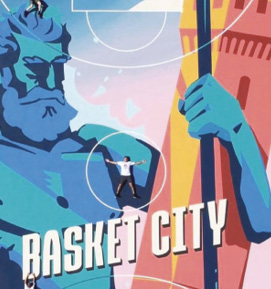In Bologna, spring means living outdoors: when warm weather arrives, everyone goes to the city’s many parks, which fill up with jugglers, children, tenacious readers, and impromptu study groups. And this is also when Bologna turns into Basket City, the term used by players and spectators to describe the historical local rivalry, almost fiercer than the one between the Asinellis and the Garisendas. If in the mid-‘90s Chicago had MJ, in the late ‘90s had Saša Danilovic and Carlton Myers competing for the championship. Some may say that the days of Basket City are over, but all you have to do is walk around the city in spring to see the unbreakable bond between the Bolognese and basketball. Among the many outdoor courts, there is a special one in the Graziella Fava Garden, a green triangle within the 14th century walls outside the main train station. The Fava Garden is dedicated to a victim of 1970s terrorism, killed in the attack on the Emilia-Romagna and Marches Press Association. The garden was left abandoned until 2021, when the Regaz dei Fava association launched a renovation project with an inclusive and anti-racist approach, putting the court (and therefore basketball) at the center. Moving outside the walls, toward the Savena district, we have the Lunetta Gamberini Park, also simply called the Lunetta. The name derives from the military constructions called lunettes ordered by General Fanti in the mid-1800s to provide an additional line of defense at the city gates. The trenches were dismantled in 1889 when no longer needed, and just a few buildings were preserved, such as a mercury fulminate plant owned by the Gamberini family.

The Lunetta had to wait until 1985 for work to be completed, giving the area its current form: 145,000 m2 with, in addition to schools and a senior citizens center, a gym and a sports center with outdoor for basketball, volleyball, and tennis courts, a field for American football and soccer, and a skating rink. Also outside the city, on the boundary between San Donato and the Cirenaica (the Resistance neighborhood built in the days of the Italian-Turkish war) is the Savena court on Via Libia, perhaps the simplest and most authentic of all: made of concrete, it is in the center of a green space with tennis, volleyball, and paddleball courts. A working-class neighborhood with small townhouses managed by the Risanamento Cooperative, the names of the Cirenaica’s streets were changed from those of Libyan colonies to those of partisans and patriots. The most famous court is obviously the one in the Margherita Gardens, where every June thousands of fans gather to enjoy a month of life-and-death games of the Playground Tournament. Although amateur, there have been some famous fans and players at the games, including Mago (AKA Andrea Bargnani) and Gimbo (AKA Gianmarco Tamberi). Considered the best court in Italy, the Playground is coveted ground for anyone who wants to make a name on the Bolognese basketball scene. The Gardens (as the Bolognese call the city’s largest park – 260,000 m2) have maintained most of their original 1879 form as a romantic English garden. Although the Fortitudo team is now in Series B and the Virtus team is in Eurolega, and although the Bolognese don’t know when they’ll be able to relive the exploits of Basket City, they do know that in spring it’s a good idea to bring a basketball wherever they go.





.png)